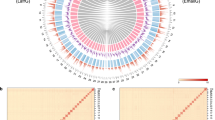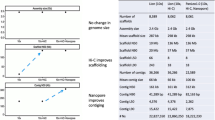Abstract
Background
There are three species of elephant that exist, the Asian elephant (Elephas maximus) and two species of African elephant (Loxodonta africana and Loxodonta cyclotis). The populations of all three species are dwindling, and are under threat due to factors, such as habitat destruction and ivory hunting. The species differ in many respects, including in their morphology and response to disease. The availability of elephant genome sequence data from all three elephant species will complement studies of behaviour, genetic diversity, evolution and disease resistance.
Findings
We present low-coverage Illumina sequence data from two Asian elephants, representing approximately 5X and 2.5X coverage respectively. Both raw and aligned data are available, using the African elephant (L. africana) genome as a reference.
Conclusions
The data presented here are an important addition to the available genetic and genomic information on Asian and African elephants.
Similar content being viewed by others
Data description
Background
Three species of elephant exist, the Asian elephant (Elephas maximus)[1] and two species of African elephant (Loxodonta africana, Loxodonta cyclotis)[2, 3]. Elephants are the Earth's largest land mammal, with the Asian elephant (E. maximus) being slightly smaller than African elephants (L. africana and L. cyclotis). Elephants can reach a height of 4 m, a weight of over 10,000 kg, and adults can have a lifespan as long as 60–70 years. Asian elephants have the following distinctive characteristics: smaller rounded ears, arched back, hemispherical bulges on the head, differing number of nails on the legs, and finger-like features on the trunk. Asian elephant males and both sexes of African elephants can grow tusks over 2 m in length and 45 kg in weight. Asian elephants also have fewer ribs, more molar plates and a small intestine twice as long as that in African elephants[1, 2, 4]. The elephant species also differ in their nutritional needs[5] and susceptibility to infectious diseases[6].
Characteristic features of elephants make these animals unique. Elephant trunks have many functions (smelling, breathing, trumpeting, drinking and grabbing) and contain approximately 150,000 different muscle fascicles[7], the largest number in any single body part. Elephants have also a longer gestation period than any other mammal, almost 22 months[8]. At birth, elephant calves already weigh some 90 kg and stand about 1 m tall.
Both E. maximus and L. africana are listed as endangered species by the International Union for Conservation of Nature (IUCN)[9]. Wild populations are restricted to increasingly limited areas of land and are under pressure with regard to habitat loss, poaching, human invasion and various diseases.
The genome of the African elephant, L. africana, has been sequenced to 6.8X coverage by The Broad Institute[10] (Genbank Assembly ID: GCA_000001905.1; BioProject accession ID: PRJNA12569) and has been annotated by Ensembl[11]. Here, we present whole-genome sequencing datasets from two Asian elephants (E. maximus), both of which are an important addition to the existing public data. The availability and a better understanding of elephant genomes will facilitate efforts to conserve populations of these animals by enabling studies of behaviour, social organisation, population structure, genetic diversity and phylogeny. In addition, the genome sequences will facilitate development of novel tools to aid in combating the illegal trade of wild elephant and ivory, as well as deciphering their body physiology and immunity.
Original purpose
Two samples, 577_1_Emelia and 577_2_Raman, were originally sequenced to enable the characterisation of elephant endotheliotropic herpesvirus (EEHV)[12], which is associated with a life-threatening haemorrhagic disease in Asian elephants[6]. Despite the virus representing only a tiny fraction of the reads (0.169% and 0.038% respectively), full genome sequences of both EEHV1A and EEHV1B were recovered. A small number of the reads were also used in the resolution of the type specimen of the Asian elephant (E. maximus), which was instead found to originate from an elephant of the Loxodonta genus[13].
Sample treatment and sequencing
Sample collection, treatment and sequencing have been previously described[12]. Briefly, post-mortem samples were collected from two infant Asian elephants, Emelia (female)[14] and Raman (male)[15], from two UK zoos. The individuals were a similar age at death: 2 years 8 months 11 days (Raman) and 2 years 9 months (Emelia). DNA was extracted from heart (Raman) and tongue (Emelia). From each sample, 5 μg of DNA was treated with NEBNext double-stranded DNA fragmentase (New England BioLabs, Ipswich, MA). Sequencing libraries were constructed using an Illumina TruSeq DNA sample preparation kit. The libraries were sequenced on an Illumina HiSeq 2000 (Illumina, San Diego, CA) instrument at Edinburgh Genomics (University of Edinburgh), resulting in 76 bp paired-end datasets.
Bioinformatics, data description and availability
The data are deposited in the European Nucleotide Archive (ENA) under accession [EMBL:ERP004241], and consist of 97.6 million (577_1_Emelia) and 53.8 million (577_2_Raman) paired 76 bp reads. Assuming a genome size of 3.1Gb, the sequence data described here represent 4.8X and 2.6X theoretical coverage respectively. The insert size for each library is approximately 350 bp. The reads have been aligned to the African elephant genome (Loxafr3.0, INSDC Assembly GCA_000001905.1, Jul 2009) using bwa[16] and converted to BAM by Samtools[17]. The vast majority of the Asian elephant sequence reads align to the African elephant genome: 94.66% (577_1_Emelia) and 93.82% (577_2_Raman). The percentage of bases in the L. africana assembly covered by at least one read from the Asian samples are 94.18% and 84.76% for 577_1_Emelia, and 577_2_Raman respectively. These coverage percentages were calculated using the mpileup tool from Samtools[17] package (version 0.1.18) with the option –C set to 50.
Availability of supporting data
The datasets supporting the results of this article are available in the European Nucleotide Archive (ENA) under accession [EMBL:ERP004241], as well as the GigaScience, GigaDB repository[18].
Abbreviations
- Bp:
-
Base-pairs
- EEHV:
-
Elephant endotheliotropic herpesvirus
- Gb:
-
Gigabases
- IUCN:
-
International Union for Conservation of Nature
- kg:
-
Kilograms
- m:
-
Metres.
References
Shoshani J, Eisenberg JF: Elephas maximus. Mamm Species. 1982, 1-8. 182
Laursen L, Bekoff M: Loxodonta africana. Mamm Species. 1978, 1-8. 92
Roca AL, Georgiadis N, Pecon-Slattery J, O'Brien SJ: Genetic evidence for two species of elephant in Africa. Science. 2001, 293 (5534): 1473-1477. 10.1126/science.1059936.
Sukumar R: The living elephants: evolutionary ecology, behavior, and conservation. 2003, Oxford: Oxford University Press
van Sonsbeek GR, van der Kolk JH, van Leeuwen JP, Everts H, Marais J, Schaftenaar W: Effect of calcium and cholecalciferol supplementation on several parameters of calcium status in plasma and urine of captive Asian (Elephas maximus) and African elephants (Loxodonta africana). J Zoo Wildl Med. 2013, 44 (3): 529-540. 10.1638/2010-0123R4.1.
Ossent P, Guscetti F, Metzler AE, Lang EM, Rubel A, Hauser B: Acute and fatal herpesvirus infection in a young Asian elephant (Elephas maximus). Vet Pathol. 1990, 27 (2): 131-133. 10.1177/030098589002700212.
Shoshani J: Understanding proboscidean evolution: a formidable task. Trends Ecol Evol. 1998, 13 (12): 480-487. 10.1016/S0169-5347(98)01491-8.
Hildebrandt TB, GÖRitz F, Hermes R, Reid C, Dehnhard M, Brown JL: Aspects of the reproductive biology and breeding management of Asian and African elephants Elephas maximus and Loxodonta africana. International Zoo Yearbook. 2006, 40 (1): 20-40. 10.1111/j.1748-1090.2006.00020.x.
The IUCN Red List of Threatened Species. [http://www.iucnredlist.org/]
Elephant genome project. [https://www.broadinstitute.org/scientific-community/science/projects/mammals-models/elephant/elephant-genome-project]
Flicek P, Amode MR, Barrell D, Beal K, Billis K, Brent S, Carvalho-Silva D, Clapham P, Coates G, Fitzgerald S, Gil L, Giron CG, Gordon L, Hourlier T, Hunt S, Johnson N, Juettemann T, Kahari AK, Keenan S, Kulesha E, Martin FJ, Maurel T, McLaren WM, Murphy DN, Nag R, Overduin B, Pignatelli M, Pritchard B, Pritchard E, Riat HS: Ensembl 2014. Nucleic Acids Res. 2014, 42 (Database issue): D749-755.
Wilkie GS, Davison AJ, Watson M, Kerr K, Sanderson S, Bouts T, Steinbach F, Dastjerdi A: Complete genome sequences of elephant endotheliotropic herpesviruses 1A and 1B determined directly from fatal cases. J Virol. 2013, 87 (12): 6700-6712. 10.1128/JVI.00655-13.
Cappellini E, Gentry A, Palkopoulou E, Ishida Y, Cram D, Roos A-M, Watson M, Johansson US, Fernholm B, Agnelli P, Barbagli F, Littlewood DTJ, Kelstrup CD, Olsen JV, Lister AM, Roca AL, Dalén L, Gilbert MTP: Resolution of the type material of the Asian elephant, Elephas maximus Linnaeus, 1758 (Proboscidea, Elephantidae). Zool J Linnean Soc. 2014, 170 (1): 222-232. 10.1111/zoj.12084.
Elephant database (Emelia). [http://www.elephant.se/database2.php?elephant_id=779]
Elephant database (Raman). [http://www.elephant.se/database2.php?elephant_id=581]
Li H, Durbin R: Fast and accurate short read alignment with Burrows-Wheeler transform. Bioinformatics. 2009, 25 (14): 1754-1760. 10.1093/bioinformatics/btp324.
Li H, Handsaker B, Wysoker A, Fennell T, Ruan J, Homer N, Marth G, Abecasis G, Durbin R: The Sequence Alignment/Map format and SAMtools. Bioinformatics. 2009, 25 (16): 2078-2079. 10.1093/bioinformatics/btp352.
Dastjerdi A, Robert C, Watson M: Supporting data for "Low coverage sequencing of two Asian elephant (Elephas maximus) genomes". GigaSci. 2014, Database http://dx.doi.org/10.5524/100095
Acknowledgements
The work was enabled by funding from the Biotechnology and Biological Sciences Research Council including Institute Strategic Programme and National Capability grants (BBSRC; BBS/E/D/20310000, BB/J004243/1). DNA sequencing was provided by Edinburgh Genomics (http://genomics.ed.ac.uk). The authors thank the staff at Chester and Whipsnade Zoos, UK for the elephant tissues and Willem Schaftenaar, Rotterdam zoo (The Netherlands) for his advice on the manuscript.
Author information
Authors and Affiliations
Corresponding author
Additional information
Competing interests
The authors declare they have no competing interests.
Authors’ contributions
AD conceived the study, provided samples and helped write the paper; CR carried out bioinformatics analysis and helped write the paper; MW conceived the study, carried out bioinformatics analysis and helped write the paper. All authors read and approved the final manuscript.
Akbar Dastjerdi, Christelle Robert contributed equally to this work.
Rights and permissions
This article is published under an open access license. Please check the 'Copyright Information' section either on this page or in the PDF for details of this license and what re-use is permitted. If your intended use exceeds what is permitted by the license or if you are unable to locate the licence and re-use information, please contact the Rights and Permissions team.
About this article
Cite this article
Dastjerdi, A., Robert, C. & Watson, M. Low coverage sequencing of two Asian elephant (Elephas maximus) genomes. GigaSci 3, 12 (2014). https://doi.org/10.1186/2047-217X-3-12
Received:
Accepted:
Published:
DOI: https://doi.org/10.1186/2047-217X-3-12




